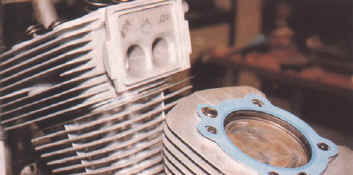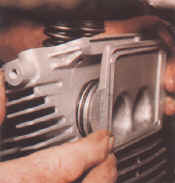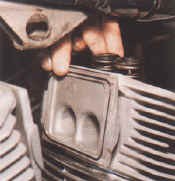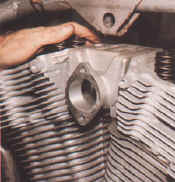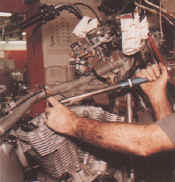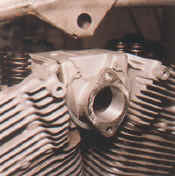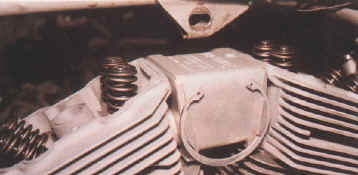|
If you decide you need to change the base gaskets or cylinder studs
without re-ringing the engine, you can do so by pulling the cylinder
high enough so that you can get at the wrist pin locks without the
rings coming out of the cylinder. CAUTION:
Be sure to insert clean shop towels into crankcase openings as
soon as the spigot clears them to keep out dirt and other foreign
material. Remove
one wrist pin lock and carefully remove wrist pin. The cylinder and
piston can now be removed as an assembly. Push the piston back into the
bore and set the cylinder aside until you are ready to assemble it. Re-assemble
the cylinder when you are ready by reversing procedure and using a new
wrist pin lock. When cylinders are secure set up a dial indicator on
the front piston and find top dead center. (1.D.C.) Set the indicator to
read zero, then rotate the engine backward (clockwise) until the
piston is .248 inches deep in the cylinder. Remove the timing plug from
the crankcase and stamp a new timing mark on the flywheel centered in
the hole. Repeat the same procedure for the other cylinder. The new
timing marks are not at 25. We installed a set of James head gaskets and
a new set of 0-rings. Apply
never seize to the threads of the two head bolts already installed in
the head and start pulling them down until they just start on the
dowels. Install the other two bolts and washers, making sure the washers
are flat side down. Use an X-pattern and pull all four down until the
head just touches the gasket. Repeat the procedure on the other head.
Put a spark plug in the hole but do not start to thread. It's just
insurance to keep stuff out of the cylinders. Put 0-rings on the manifold runners and grease them with a good 0-ring lubricant. Pull evenly into intake ports. Install 0-rings on runner faces, again using a good lube and slide the plenum into place. Take care not to disturb the 0-rings. Once you are certain the plenum is positioned correctly and the 0-rings are in position, install snap rings that hold the plenum together.
|
